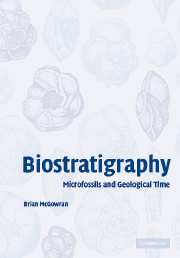Book contents
- Frontmatter
- Contents
- Preface
- Acknowledgments
- 1 Biogeohistory and the development of classical biostratigraphy
- 2 The biostratigraphy of fossil microplankton
- 3 Biostratigraphy: its integration into modern geochronology
- 4 Biostratigraphy and biohistorical theory I: evolution and correlation
- 5 Systemic stratigraphy: beyond classical biostratigraphy
- 6 Biostratigraphy and biohistorical theory II: carving Nature at the joints
- 7 Biostratigraphy and chronostratigraphic classification
- 8 On biostratigraphy and biogeohistory
- References
- Index
4 - Biostratigraphy and biohistorical theory I: evolution and correlation
Published online by Cambridge University Press: 02 December 2009
- Frontmatter
- Contents
- Preface
- Acknowledgments
- 1 Biogeohistory and the development of classical biostratigraphy
- 2 The biostratigraphy of fossil microplankton
- 3 Biostratigraphy: its integration into modern geochronology
- 4 Biostratigraphy and biohistorical theory I: evolution and correlation
- 5 Systemic stratigraphy: beyond classical biostratigraphy
- 6 Biostratigraphy and biohistorical theory II: carving Nature at the joints
- 7 Biostratigraphy and chronostratigraphic classification
- 8 On biostratigraphy and biogeohistory
- References
- Index
Summary
Summary
This chapter is centred on the planktonic foraminifera as ‘palaeobiological’ entities in biostratigraphy – their taxonomy and classification, the nature of the species-level taxa, and macroevolution as revealed in lineage studies. Larger foraminifera and mammals are also discussed in this matter of evolution and biochronology.
Two approaches to evolutionary theory
A fertile research programme in evolution and the fossil record of biodiversity is based in the fluctuating distribution of taxa through time. The philosopher Gayon (1990) identified four common solutions to the problem of the origin of biotic diversity, of which the first three were: (i) the extrapolationist models of competition, coevolution, etc.; (ii) rehabilitation of the pre-Darwinian transcendental morphology (developmental constraints, embryology); and (iii) species-level processes analogous to but not extrapolated from microevolutionary processes (species selection, species drift). Solutions (i)–(iii) are biological – not quarantined from the physical world, but not crucially driven by it, either. In contrast, Gayon cited a fourth solution: (iv) ‘much of the formation of new biota is due to major environmental changes caused by a dynamic earth resulting in major environmental change beyond biological control or limitation … This last solution might well be the most “Darwinian” of all: It comes down to saying that microevolution is a utilitarian tinkering in a changing and hazardous world.’ (Emphasis added.) (It is ironic that the appellation ‘Darwinian’ be ascribed to this last solution, because it has been said that Darwin moved away from interactions between organism and physical environment in his later thinking on evolutionary dynamics and moved closer to organism/organism interactions (Hallam, 1983).
- Type
- Chapter
- Information
- BiostratigraphyMicrofossils and Geological Time, pp. 85 - 163Publisher: Cambridge University PressPrint publication year: 2005



